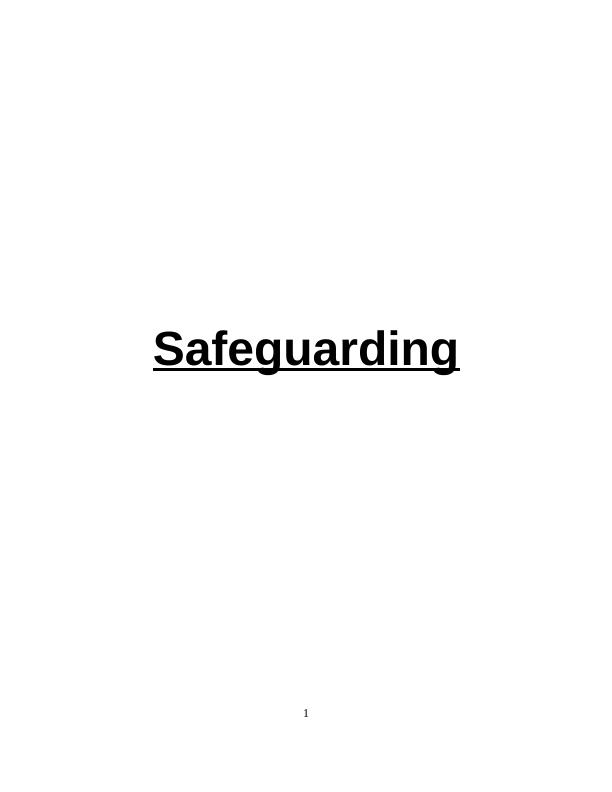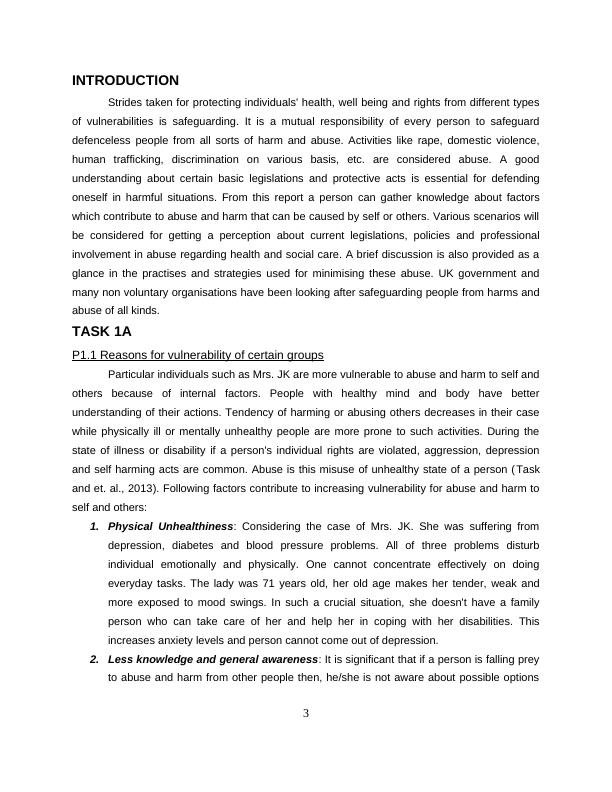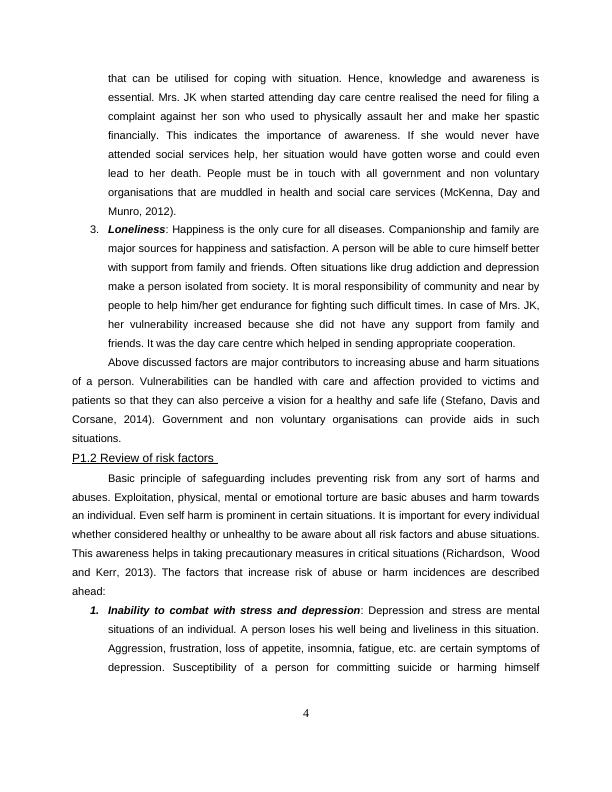Safeguarding: Reasons for Vulnerability and Impact of Social and Cultural Factors
Added on 2023-04-11
14 Pages3602 Words94 Views
Safeguarding
1
1

2

INTRODUCTION
Strides taken for protecting individuals' health, well being and rights from different types
of vulnerabilities is safeguarding. It is a mutual responsibility of every person to safeguard
defenceless people from all sorts of harm and abuse. Activities like rape, domestic violence,
human trafficking, discrimination on various basis, etc. are considered abuse. A good
understanding about certain basic legislations and protective acts is essential for defending
oneself in harmful situations. From this report a person can gather knowledge about factors
which contribute to abuse and harm that can be caused by self or others. Various scenarios will
be considered for getting a perception about current legislations, policies and professional
involvement in abuse regarding health and social care. A brief discussion is also provided as a
glance in the practises and strategies used for minimising these abuse. UK government and
many non voluntary organisations have been looking after safeguarding people from harms and
abuse of all kinds.
TASK 1A
P1.1 Reasons for vulnerability of certain groups
Particular individuals such as Mrs. JK are more vulnerable to abuse and harm to self and
others because of internal factors. People with healthy mind and body have better
understanding of their actions. Tendency of harming or abusing others decreases in their case
while physically ill or mentally unhealthy people are more prone to such activities. During the
state of illness or disability if a person's individual rights are violated, aggression, depression
and self harming acts are common. Abuse is this misuse of unhealthy state of a person ( Task
and et. al., 2013). Following factors contribute to increasing vulnerability for abuse and harm to
self and others:
1. Physical Unhealthiness: Considering the case of Mrs. JK. She was suffering from
depression, diabetes and blood pressure problems. All of three problems disturb
individual emotionally and physically. One cannot concentrate effectively on doing
everyday tasks. The lady was 71 years old, her old age makes her tender, weak and
more exposed to mood swings. In such a crucial situation, she doesn't have a family
person who can take care of her and help her in coping with her disabilities. This
increases anxiety levels and person cannot come out of depression.
2. Less knowledge and general awareness: It is significant that if a person is falling prey
to abuse and harm from other people then, he/she is not aware about possible options
3
Strides taken for protecting individuals' health, well being and rights from different types
of vulnerabilities is safeguarding. It is a mutual responsibility of every person to safeguard
defenceless people from all sorts of harm and abuse. Activities like rape, domestic violence,
human trafficking, discrimination on various basis, etc. are considered abuse. A good
understanding about certain basic legislations and protective acts is essential for defending
oneself in harmful situations. From this report a person can gather knowledge about factors
which contribute to abuse and harm that can be caused by self or others. Various scenarios will
be considered for getting a perception about current legislations, policies and professional
involvement in abuse regarding health and social care. A brief discussion is also provided as a
glance in the practises and strategies used for minimising these abuse. UK government and
many non voluntary organisations have been looking after safeguarding people from harms and
abuse of all kinds.
TASK 1A
P1.1 Reasons for vulnerability of certain groups
Particular individuals such as Mrs. JK are more vulnerable to abuse and harm to self and
others because of internal factors. People with healthy mind and body have better
understanding of their actions. Tendency of harming or abusing others decreases in their case
while physically ill or mentally unhealthy people are more prone to such activities. During the
state of illness or disability if a person's individual rights are violated, aggression, depression
and self harming acts are common. Abuse is this misuse of unhealthy state of a person ( Task
and et. al., 2013). Following factors contribute to increasing vulnerability for abuse and harm to
self and others:
1. Physical Unhealthiness: Considering the case of Mrs. JK. She was suffering from
depression, diabetes and blood pressure problems. All of three problems disturb
individual emotionally and physically. One cannot concentrate effectively on doing
everyday tasks. The lady was 71 years old, her old age makes her tender, weak and
more exposed to mood swings. In such a crucial situation, she doesn't have a family
person who can take care of her and help her in coping with her disabilities. This
increases anxiety levels and person cannot come out of depression.
2. Less knowledge and general awareness: It is significant that if a person is falling prey
to abuse and harm from other people then, he/she is not aware about possible options
3

that can be utilised for coping with situation. Hence, knowledge and awareness is
essential. Mrs. JK when started attending day care centre realised the need for filing a
complaint against her son who used to physically assault her and make her spastic
financially. This indicates the importance of awareness. If she would never have
attended social services help, her situation would have gotten worse and could even
lead to her death. People must be in touch with all government and non voluntary
organisations that are muddled in health and social care services (McKenna, Day and
Munro, 2012).
3. Loneliness: Happiness is the only cure for all diseases. Companionship and family are
major sources for happiness and satisfaction. A person will be able to cure himself better
with support from family and friends. Often situations like drug addiction and depression
make a person isolated from society. It is moral responsibility of community and near by
people to help him/her get endurance for fighting such difficult times. In case of Mrs. JK,
her vulnerability increased because she did not have any support from family and
friends. It was the day care centre which helped in sending appropriate cooperation.
Above discussed factors are major contributors to increasing abuse and harm situations
of a person. Vulnerabilities can be handled with care and affection provided to victims and
patients so that they can also perceive a vision for a healthy and safe life (Stefano, Davis and
Corsane, 2014). Government and non voluntary organisations can provide aids in such
situations.
P1.2 Review of risk factors
Basic principle of safeguarding includes preventing risk from any sort of harms and
abuses. Exploitation, physical, mental or emotional torture are basic abuses and harm towards
an individual. Even self harm is prominent in certain situations. It is important for every individual
whether considered healthy or unhealthy to be aware about all risk factors and abuse situations.
This awareness helps in taking precautionary measures in critical situations (Richardson, Wood
and Kerr, 2013). The factors that increase risk of abuse or harm incidences are described
ahead:
1. Inability to combat with stress and depression: Depression and stress are mental
situations of an individual. A person loses his well being and liveliness in this situation.
Aggression, frustration, loss of appetite, insomnia, fatigue, etc. are certain symptoms of
depression. Susceptibility of a person for committing suicide or harming himself
4
essential. Mrs. JK when started attending day care centre realised the need for filing a
complaint against her son who used to physically assault her and make her spastic
financially. This indicates the importance of awareness. If she would never have
attended social services help, her situation would have gotten worse and could even
lead to her death. People must be in touch with all government and non voluntary
organisations that are muddled in health and social care services (McKenna, Day and
Munro, 2012).
3. Loneliness: Happiness is the only cure for all diseases. Companionship and family are
major sources for happiness and satisfaction. A person will be able to cure himself better
with support from family and friends. Often situations like drug addiction and depression
make a person isolated from society. It is moral responsibility of community and near by
people to help him/her get endurance for fighting such difficult times. In case of Mrs. JK,
her vulnerability increased because she did not have any support from family and
friends. It was the day care centre which helped in sending appropriate cooperation.
Above discussed factors are major contributors to increasing abuse and harm situations
of a person. Vulnerabilities can be handled with care and affection provided to victims and
patients so that they can also perceive a vision for a healthy and safe life (Stefano, Davis and
Corsane, 2014). Government and non voluntary organisations can provide aids in such
situations.
P1.2 Review of risk factors
Basic principle of safeguarding includes preventing risk from any sort of harms and
abuses. Exploitation, physical, mental or emotional torture are basic abuses and harm towards
an individual. Even self harm is prominent in certain situations. It is important for every individual
whether considered healthy or unhealthy to be aware about all risk factors and abuse situations.
This awareness helps in taking precautionary measures in critical situations (Richardson, Wood
and Kerr, 2013). The factors that increase risk of abuse or harm incidences are described
ahead:
1. Inability to combat with stress and depression: Depression and stress are mental
situations of an individual. A person loses his well being and liveliness in this situation.
Aggression, frustration, loss of appetite, insomnia, fatigue, etc. are certain symptoms of
depression. Susceptibility of a person for committing suicide or harming himself
4

End of preview
Want to access all the pages? Upload your documents or become a member.
Related Documents
Safeguarding and Protection of Vulnerable Adultslg...
|10
|3983
|258
Safeguarding in Health and Social Care PDFlg...
|12
|3610
|52
Assignment on Safeguarding in Health and Social Carelg...
|5
|1058
|42
Significance of Ethical and Professional Behaviours in Occupational Therapylg...
|6
|1316
|186
Safeguarding Children: Reflection on a Case of Sexual Exploitationlg...
|16
|5150
|20
TASK 11: Reasons why an individual or a group may be vulnerable to abuse or harm to self or otherslg...
|10
|3675
|84
